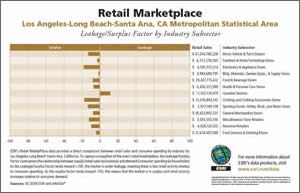Discover Retail Opportunities with Esri's Retail MarketPlace Data
By Brent Roderick, Esri Product Marketing
How can you find business opportunities in this tough economy? With information that provides a complete, current, and accurate snapshot of the retail activity in your area. This information is critical when you're deciding how to increase your existing business or selecting another location for a new store.
 This example from Esri's Retail MarketPlace data shows the demand for gasoline stations is greater than the supply in the Los Angeles-Long Beach-Santa Ana Metropolitan Statistical Area. |
You can measure retail activity in your market area by studying supply and demand. If you examine business revenues and retail sales by area, you will learn about the types of retailers in your area by industry segment. Analysis of consumer spending reveals the demand in a market or the potential for a particular type of retail business.
Esri offers ways to assess both supply and demand of retail activity in its 2009 Retail MarketPlace database, which provides the latest statistics for the retail market by the North American Industry Classification System (NAICS) categories. Some of these categories include Motor Vehicle and Parts Dealers; Building Material, Garden Equipment and Supplies Dealers; Food and Beverage Stores; and Food Services and Drinking Places.
The database also includes the proprietary Leakage/Surplus Factor. This feature measures the difference between the volume of supply (retail sales) generated by the retail industry and the demand (spending by households; i.e., retail potential) in the same industry.
Leakage in an area means that the market demand is greater than the supply; consumers are leaving the area to shop for products and services that are unavailable locally; therefore, demand is "leaking" out of the area. Retailers outside the trade area are fulfilling a demand for a product or service. This situation provides an opportunity for this type of store to enter the market area.
Surplus means that the supply of stores in a particular industry sector exceeds consumer demand, and retailers may attract shoppers from outside the trade area. Therefore, the "surplus" is in the market supply.
Who can use this type of data? Retailers can use the information to learn about opportunities to open new stores. City and county economic development staff and urban planners can determine the best types of business prospects to recruit for their area. Commercial real estate developers can also use the information to research opportunities and pitch their properties to prospective retailers.
Retail MarketPlace data is available in various formats, geographies, and deliverables. Learn more about Retail MarketPlace data.